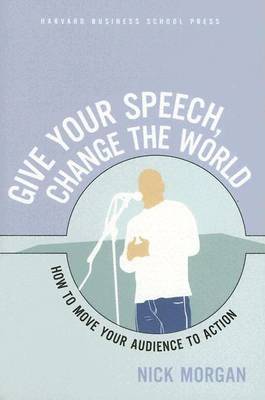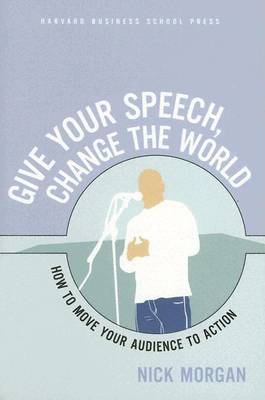
Door een staking bij bpost kan je online bestelling op dit moment iets langer onderweg zijn dan voorzien. Dringend iets nodig? Onze winkels ontvangen jou met open armen!
- Afhalen na 1 uur in een winkel met voorraad
- Gratis thuislevering in België vanaf € 30
- Ruim aanbod met 7 miljoen producten
Door een staking bij bpost kan je online bestelling op dit moment iets langer onderweg zijn dan voorzien. Dringend iets nodig? Onze winkels ontvangen jou met open armen!
- Afhalen na 1 uur in een winkel met voorraad
- Gratis thuislevering in België vanaf € 30
- Ruim aanbod met 7 miljoen producten
Zoeken
Give Your Speech, Change the World
How to Move Your Audience to Action
Nick Morgan
Paperback | Engels
€ 25,95
+ 51 punten
Omschrijving
Do you remember the topic of the last speech you heard? If not, you're not alone. In fact, studies show that audiences remember only 10% to 30% of speech or presentation content. Given those bleak statistics, why do we give speeches at all? We give them, says communications expert Nick Morgan, because they remain the most powerful way of connecting with audiences since ancient Greek times. But as we've evolved to a more conversational mode of public speaking, thanks to television, we have forgotten much of what the Greeks taught us about the nonverbal aspects of speech-giving: the physical connection with audiences that can create an almost palpable emotional bond. Morgan says this "kinesthetic connection" comes from truly listening to your audience--not just with your brain but with your body. In this book, he draws from more than 20 years as a speech coach and consultant, combining the best of ancient Greek oratory with modern communications research to offer a new, audience-centered approach to public speaking. Through entertaining and insightful examples, Morgan illustrates a 3 part process--focusing on content development, rehearsal, and delivery--that will enable readers of all experience levels to give more effective, passion-filled speeches that move audiences to action.
Specificaties
Betrokkenen
- Auteur(s):
- Uitgeverij:
Inhoud
- Aantal bladzijden:
- 240
- Taal:
- Engels
Eigenschappen
- Productcode (EAN):
- 9781591397144
- Verschijningsdatum:
- 1/02/2005
- Uitvoering:
- Paperback
- Formaat:
- Trade paperback (VS)
- Afmetingen:
- 143 mm x 209 mm
- Gewicht:
- 249 g

Alleen bij Standaard Boekhandel
+ 51 punten op je klantenkaart van Standaard Boekhandel
Beoordelingen
We publiceren alleen reviews die voldoen aan de voorwaarden voor reviews. Bekijk onze voorwaarden voor reviews.











